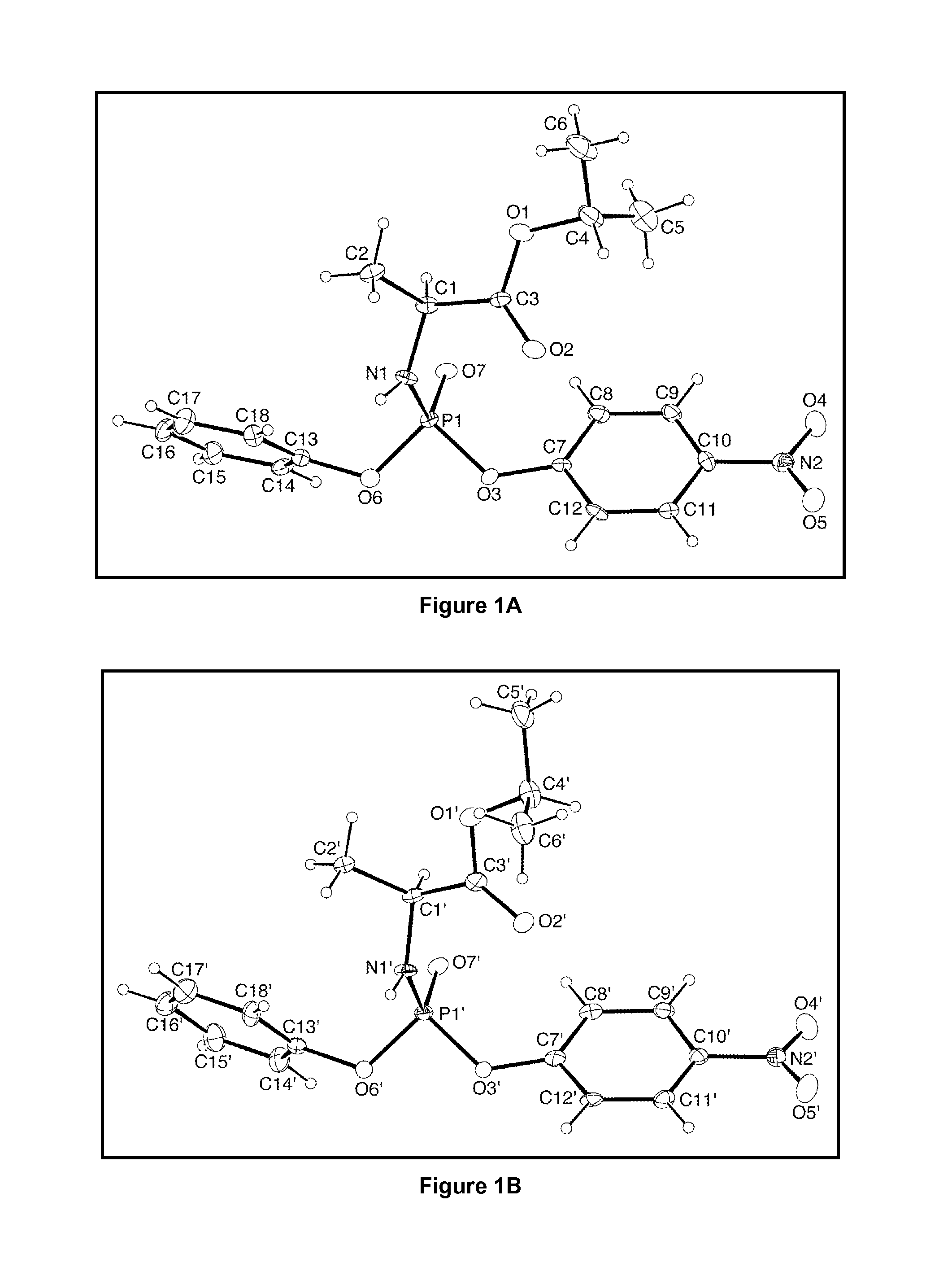Stereoselective synthesis of phosphorus containing actives
a phosphorus and active technology, applied in the field of phosphoruscontaining actives, can solve the problems of limiting the usefulness of drugs, liver failure and death of organisms, and serious injuring the liver
- Summary
- Abstract
- Description
- Claims
- Application Information
AI Technical Summary
Benefits of technology
Problems solved by technology
Method used
Image
Examples
embodiments
[0070]A first embodiment is directed to a composition comprising an enantiomerically- or a diastereomerically-enriched phosphorus-containing active, salt, or pharmaceutically acceptable salt thereof, of formula I:
[0071]
[0072]wherein Active comprises a functional group capable of forming a bond to P; Group is as defined herein; and W is an aryl or —(CH2)nSC(O)C(CH3)m(CH2OH)3-m, where n is 2 or 3 and m is 0, 1, 2, or 3.
[0073]A first aspect of the first embodiment is directed to a composition comprising an enantiomerically- or a diastereomerically-enriched phosphorus-containing active, salt, or pharmaceutically acceptable salt thereof, of formula I:
[0074]
[0075]wherein Active comprises a nucleoside, nucleoside-analog, or non-nucleoside compound; Group is as defined herein; and W is an aryl or —(CH2)nSC(O)C(CH3)m(CH2OH)3-m, where n is 2 or 3 and m is 0, 1, 2, or 3.
[0076]A second aspect of the first embodiment is directed to a composition comprising an enantiomerically- or a diastereomeri...
example 1
Preparation of 2′-deoxy-2′-fluoro-2′-C-methyluridine (23)
[0370]In a 10 L flask, was added 3′,5′-O-dibenozyl-2′-deoxy-2′-fluoro-2′-C-methyl-N4-benzoylcytidine 107 (500 g, 0.874 mol) and 70% aqueous acetic acid (7.5 L). The solution was heated to reflux (110° C.) for 20 h. TLC indicated a complete reaction (Rf 0.6 in 5% methanol in dichloromethane (DCM)). The mixture was cooled to ambient temperature and diluted with water (2 L). After stirring for 2 h, the resulting precipitate was collected by filtration and the solid was rinsed with water (5 L) and dried in the atmosphere at ambient temperature for 12 h to afford 360 g (88%). This dibenzoyluridine intermediate, 108, was used directly in the next step by adding it all to freshly prepared methanolic ammonia (5.4 L, ca 25%) at 0° C. This temperature was maintained for 3 h and then allowed to warm to 15° C. for 24 h. TLC indicated a complete reaction (Rf 0.4 in 10% methanol in DCM). The reaction mixture was filtered through a Celite be...
example 2
Preparation of 110
[0371]
[0372]To a stirred solution of 1-((2R,3R,4R,5R)-3-Fluoro-4-hydroxy-5-hydroxymethyl-3-methyl-tetrahydro-furan-2-yl)-1H-pyrimidine-2,4-dione 23 (32 mg, 0.12 mmol) in dry THF (1 mL) was added a 1M solution of tButylmagnesium chloride (0.26 mL, 0.26 mmol, 2.1 equiv)) at room temperature over a period of 3 min. After 30 min, a solution of (S)-2-[(R)-(4-nitro-phenoxy)-phenoxy-phosphorylamino]propionic acid isopropyl ester (109) in THF (0.5 mL) was added drop wise over a period of 3 min. The mixture was allowed to stir at room temperature for 42 h and then quenched with saturated aqueous NH4Cl (10 mL). The mixture was partitioned between ethyl acetate and water. The combined organic extract was dried over anhydrous sodium sulfate and concentrated. The residue was chromatographed using 0-4% methanol / dichloromethane gradient to give 110 as foamy solid (29 mg, 44.5% yield).
[0373]110 Data:
[0374]1H-NMR (CDCl3) δ 8.63 (br s, 1H, NH), 7.47 (d, 1H, C6-H), 7.30 (m, 2H, o-aro...
PUM
| Property | Measurement | Unit |
|---|---|---|
| mol % | aaaaa | aaaaa |
| mol % | aaaaa | aaaaa |
| mol % | aaaaa | aaaaa |
Abstract
Description
Claims
Application Information
 Login to View More
Login to View More - R&D
- Intellectual Property
- Life Sciences
- Materials
- Tech Scout
- Unparalleled Data Quality
- Higher Quality Content
- 60% Fewer Hallucinations
Browse by: Latest US Patents, China's latest patents, Technical Efficacy Thesaurus, Application Domain, Technology Topic, Popular Technical Reports.
© 2025 PatSnap. All rights reserved.Legal|Privacy policy|Modern Slavery Act Transparency Statement|Sitemap|About US| Contact US: help@patsnap.com



